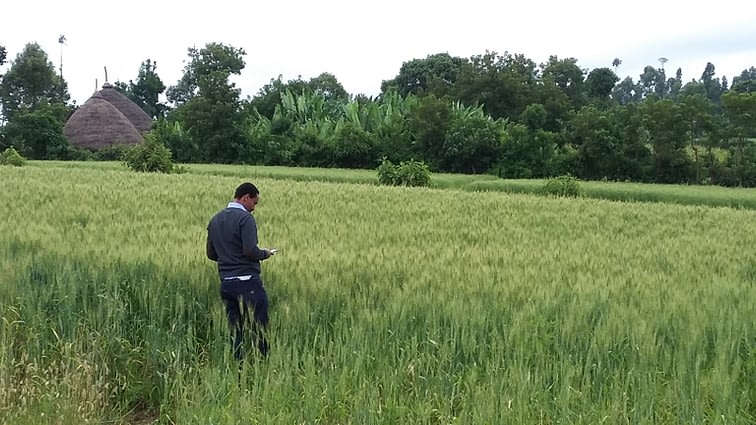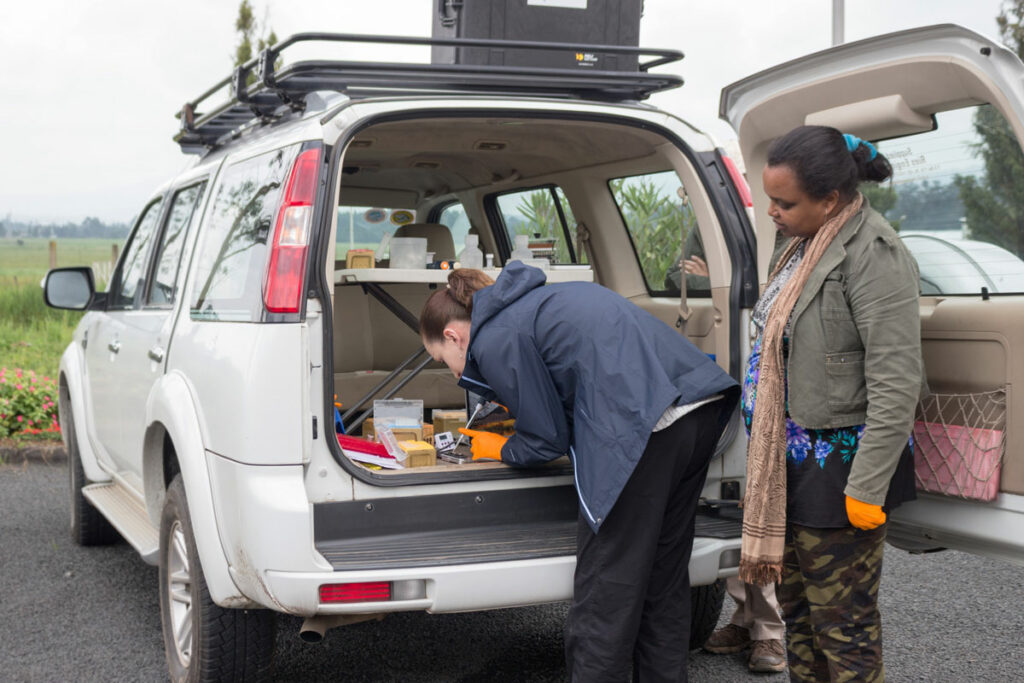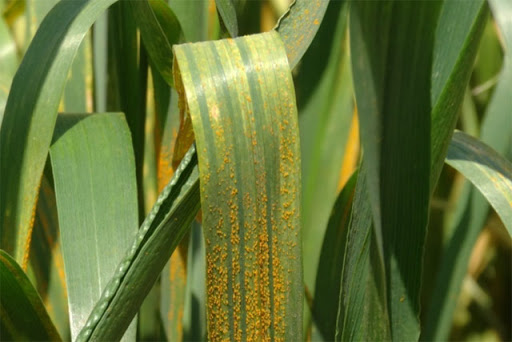The following blog post focuses on innovative and impactful uses of mobile technology to help mitigate the devastating impacts of wheat rust on crop yields in Ethiopia. This post owes to the work of Dr. Dave Hodson, and Dr. Diane Saunders and their various global partners, and relies on the references posted at the end of the page for its content. Any replication of their material is complimentary in its intention, and should only serve to highlight my own interest in the work carried out.
Part One: Wheat Rust – An Early Warning System
The world’s cereal and horticultural crops have always been threatened by the fungal disease rust (wheat yellow rust, stem rust, and leaf rust), a pathogen that can wreak havoc on croplands. Estimated global annual wheat losses due to rust are roughly 5.47 million tonnes (1). One country particularly vulnerable to wheat rust is Ethiopia, where the pathogen is considered the ‘key biological constraint to wheat production’ (Meyer et al. 2021). Wheat rusts have move quickly over land, carried vast distances by the wind, meaning epidemics take root quickly with devastating effects. These reduced yields pressurize the agricultural economy of Ethiopia, leading to annual wheat import costs of around $600 million, this in spite of them being the Sub-Saharan Africa region’s largest wheat producer.
Traditional mitigation efforts include breeding rust-resistant varieties and applying fungicides to the croplands. Neither of these, however, can be considered a ‘silver bullet’ solution in Ethiopia with devastating new strains threaten the efficacy of the former, and supply issues impacting the latter. New tactics to combat wheat rust need to be developed and perfected, with a new early warning system spearheaded by the University of Cambridge (UOC) and their international partners showing promise. Mobile phone and field surveillance data, in combination with forecasts for environmental suitability and spore dispersal underpin the new early warning system. It empowers farmers and policy makers across the country to gauge the threat posed by rust and make predictions up to one week ahead of impact (CIMMYT).
The EWS in Action
The Ethiopian Institute of Agricultural Research (EIAR), the International Maize and Wheat Improvement Center (CIMMYT), and regional research centers carry out wheat rust surveys, generating real-time data using Open Data Kit (ODK), a smartphone app. Additionally, the Ethiopian Agricultural Transformative Agency (ATA) Farmer’s Hotline provide complimentary data. The UOC, in collaboration with the UK Met Office in turn use the results of these surveys to develop automated 7-day wheat rust spore dispersal forecasts, based on the data indicating disease presence.

This data is fed the early warning unit, and this in turn updates daily on an automated basis, with national authorities and development agencies receiving a weekly advisory report which they pass on to farmers and researchers. Farmers on the ground will receive SMS text alerts when wheat rust poses a significant risk, allowing them up to three weeks to take appropriate measures. This revolutionary system allows key stakeholders in Ethiopia to target areas at the highest risk with their limited supplies of fungicide. The goal of the project is to help Ethiopia to become self-sufficient in terms of wheat production by 2023.
Part Two: MARPLE diagnostics – Mobile And Real-time PLant DisEase
One of the big issues that arises when a wheat rust epidemic takes hold in Ethiopia has always been the delay in diagnosing the strain impacting the crops. In the past, samples would have to be sent abroad for analysis, with results often taking months to be reported back. Dr Diane Saunders, in collaboration with Dr. Tadessa Daba of EIAR and Dr. Dave Hodson of CIMMYT developed ‘a genomic-based approach for rapid point-of-care fungal disease diagnostics’ to mitigate this problem (acaciaafrica.org). MARPLE Diagnostics, the result of their research, allows for the identification of fungal strains on the ground in Ethiopia within two days. MARPLE is in effect, an analysis laboratory that fits in a suitcase meaning researchers can identify wheat rust strains rapidly.

Puccinia striiformis f. sp. tritici (PST), the pathogen that causes wheat yellow rust can lead to yield losses of about 60 percent, devastating croplands and farmers. New strains are always evolving, and the pathogen has been growing more virulent, adapting to warmer temperatures associated with climate change, attacking wheat crops aggressively. The early warning system spoke about in the first section of the blog post is only so effective where the strain of rust spore threatening the area is unknown. The complimentary nature of MARPLE strengthens provides a potent weapon in the fight against wheat yield loss in Ethiopia. MARPLE makes use of the hand-held, portable MinION sequencing device designed by Oxford Nanopore Technologies, providing point-of-care, real-time surveillance and disease diagnostics for fungal pathogens such as wheat rust. Specific regions of the fungal pathogen’s genome are sequenced on the MinION sequencer, and this can be used to identify separate wheat yellow rust strains and monitor important genes for mutations such as fungicide target genes.
Discussion
I hope this blog post has highlighted just some of the innovative thinking that can help in the ongoing fight against food insecurity globally. The challenges faced by farmers and key actors in Ethiopia mirror those faced by some of the most disadvantaged agricultural workers across the globe. Ever-evolving pathogens, increasing temperatures, and the proliferation of unpredictable extreme weather events pose critical threats to food security in many regions of our planet. The continued funding of programmes aimed at designing technology to mitigate these challenges, and facilitating their production and use in the poorest countries will underpin humanity’s efforts to achieve an equitable, food secure world. We must continue to work together, sharing both our ideas and resources, and focus on tackling the issues we face through a climate justice lens.
References
Acaciaafrica.org. Innovator of the year award recognizes impact of international collaboration in wheat disease diagnostics. https://acaciaafrica.org/innovator-of-the-year-award-recognises-impact-of-international-collaboration-in-wheat-disease-diagnostics/
CGIAR. Inspire Challenge. Real-time diagnostics for devastating wheat rust. https://bigdata.cgiar.org/digital-intervention/real-time-diagnostics-for-devastating-wheat-rust-in-ethiopia-marple-diagnostics/
CIMMYT, 2019 Scientist develop an early warning system that delivers wheat rust predictions directly to farmers’ phones. https://www.cimmyt.org/news/scientists-develop-an-early-warning-system-that-delivers-wheat-rust-predictions-directly-to-farmers-phones/
CSIRO.AU Cereal Rusts. https://www.csiro.au/en/research/plants/pathogens-weeds/cereal-rusts
Meyer M, Bacha N, Tesfaye T, Alemayehu Y, Abera E, Hundie B, et al. (2021) Wheat rust epidemics damage Ethiopian wheat production: A decade of field disease surveillance reveals national-scale trends in past outbreaks. PLoS ONE 16(2): e0245697. https://doi.org/10.1371/journal.pone.0245697


